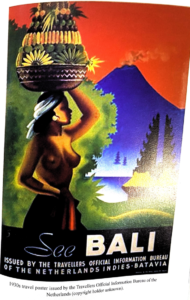Richard Holttum stated, ‘a botanic garden is essentially a museum of living plants’.1 Its position as a museum is a result of the garden’s double function; it is a place where plants can be studied by experts for science and a place where exhibits occur for the education and recreation of non-experts. Museums are also seen as having a political function and traditionally, the political function of botanic gardens originates from the garden’s position as a colonial construction. However, as this blog post will explore, in the aftermath of World War II and on the advent of Singapore’s independence, the Singapore Botanic Gardens took on a further political dimension as the garden’s award-winning orchids stemmed the beginning of ‘orchid diplomacy’. The prestigious reputation of orchids grown in the Singapore Botanic Gardens allowed the plant to provide a visible, unique symbol of nations’ friendship that was and still is today used as a tool of diplomacy.2
Holttum, who was took on the position as Director of the Gardens from 1925, is credited with the popularization of the technique of orchid hybridisation that facilitated the orchid becoming prestigious.3 However, itwas the international flower shows and exhibitions that placed Singapore’s orchids on the world map. Timothy Bernard explains that when Tan Chay Yan’s hybrid orchid the Vanda won the highest honour in the horticultural world at the Chelsea Flower Show in 1954 it placed ‘Singapore as a powerhouse on the world map of orchid cultivation.’4 The presence of the orchids within international diplomacy soon became national interest with the Sunday Standard reporting that Queen Elizabeth was presented with a bouquet of orchids flown from Singapore to London cultivated at the Botanic Gardens in Singapore.5The gifting of them to one of the most important diplomatic figures of the time, marked by the Queen’s position as Head of the British Empire that ruled over Singapore, evidences how the garden’s orchids had begun to be recognized as an important symbol for the nation within international diplomatic circles. The New Nation also reported how Singapore’s leaders were ‘saying it with orchids’ when welcoming New Zealand’s governmental visitors on their visit to the botanical gardens.6 Again, this exemplifies the plant being used as an offering of friendship within international politics. Alongside orchids being given to important foreign dignitaries, in 1956 following the nation’s independence, Singapore’s Botanic Gardens began the “VIP Orchid Naming” Program at the Gardens. This was an official government practice that named orchids for visiting dignitaries and celebrities such as Michael Jackson.7The timing of this program is also significant it began in the same year Singapore received independence, as Bernard argues the program thus exemplifies an effort from Singapore to ‘enter complex, scientific, economic and diplomatic networks’ that were not controlled or overlooked by their previous colonial rulers.8 The focus on orchids as a symbol that embodied honour and prestige not only in the Gardens but internationally continued into the late 20th century. In 1990, in an interview with The Strait Times, the Chief Executive Director of the new board at the Botanic Gardens, Dr Tan, emphasised that an ‘immediate goal was to get the Orchid Garden at the Botanic Gardens going’.9 The directors believed that this achievement would turn the botanic garden into a ‘national asset’.8This reinforces how still forty years later, the orchids were an emblem that added an additional political function into the Garden, one that impacted within national and international realms.
This blog post’s investigation using newspaper reports and Bernard’s in-depth evaluation of Singapore’s Botanic Gardens reveals how the Garden’s orchids became a symbol of friendship, prestige and honour that was recognized and respected internationally from the 1950s until the present-day. This exemplifies how the space and objects within the Garden took on many functions and how over time different functions were prioritised. If we look beyond the Garden’s traditional definition as an institution of science and consider the space as a ‘living museum’ it helps to discover and explain these differing functions. This specific case of orchid diplomacy suggests that a further investigation of the Singapore Botanic Gardens or other botanic gardens could reveal other examples of the space being used for purposes outside of the gardens traditional scientific role which suggests that it potentially providing an interesting space for a long-essay investigation.
- R. E. Holttum, “The Historical Significance of Botanic Gardens in S.E. Asia,” TAXON 19, no. 5 (1970): pp. 707-714, https://doi.org/10.2307/1219283, 707. [↩]
- Timothy P. Barnard, Nature’s Colony Empire, Nation and Environment in the Singapore Botanic Gardens (Singapore: NUS Press, 2016), 131. [↩]
- Ibid., 127. [↩]
- Ibid., 129. [↩]
- “Malayan Orchids For The Queen,” Sunday Standard, May 27, 1951, 3. [↩]
- “Saying It with Orchids,” New Nation, 1973, 3. [↩]
- Barnard, Nature’s Colony, 132. [↩]
- Ibid. [↩] [↩]
- “Turning National Parks into ‘Global Asset’,” Strait Times, June 9, 1990, 8. [↩]




